|
Table of Characteristics
This is a table of all the characteristics of Plant Hormones of which I am aware. They include the location Location, Characteristics and Occasions for Synthesis Induction and the effects the hormones have.
All items in bold are known scientific findings - references are in progress
All items with “?” are from papers known from my research notes whose dates I did not record
All items with “?” Present difficulties to the theory outlined below
All items in italics, are speculations on my part
|
Name (With Example)
|
Location, Characteristics and
Occasions for Synthesis Induction
|
Effects
|
|
Auxins
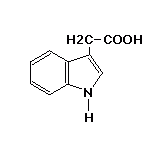
IAA
|
-
Synthesized in shoot and root meristematic tissue (Sembdner et al., 1980)
-
Synthesized in much greater amounts in the shoots than roots
-
Synthesized in young leaves (Sembdner et al., 1980)
-
Synthesized in mature leaves in very small amounts
-
IAA peaks during the day (Jahardhan et al., 1973)
-
Synthesized in mature root cells
-
Released by meristematic cells when they have more than enough Sugar ,carbon dioxide and oxygen to support both themselves and any dependent cells in peak metabolism conditions
-
Alternatively Auxin is released when it has any excess of sugar or gases above which it had previously and is proportional to the excess.
-
Third possibility is it is released when Sugar ,carbon dioxide and oxygen rise above survivable levels (a minimum level of nutrients) and is proportional to them.
-
Released by all cells when they are experiencing conditions which would normally cause a shoot meristematic cell to produce Auxin
-
Directly or indirectly induced by high levels of Ethylene
|
-
Stimulates cell elongation (Schneider, 1938)
-
Stimulates cell division with CK
-
Induces xylem and phloem (Jacobs, 1967)
-
Directly stimulates Ethylene synthesis
-
IAA inhibits Ethylene formation and transport of precursor (Wright, 1980)
-
Induces shoot apical dominance (Snow, 1945; Palmer & Phillips, 1963)
-
Inhibits abscission prior to formation of abscission layer (inhibits senescence of leaves)
-
Involved in phototropism, gravitropism, tropism toward moisture
-
Induces sugar and mineral accumulation at the site of application (Mitchell et al., 1937; Booth, ?; Davis and Wareing, ? )
-
Flower initiation
-
Sex determination
-
Induces xylem and phloem
-
Induces new root formation (Torrey, 1957; Brown et al., 1975) by breaking root apical dominance induced by CK
-
Inhibits root hair growth and causes them to die back
|
|
Cytokinins (CKs)

Zeatin
|
-
Synthesized in root and shoot meristematic tissue (Chen et al., 1985)
-
Synthesized in much greater amounts in the roots than shoots
-
Synthesized in meristematic regions of roots (van Staden & Smith, 1978)
-
Synthesized in mature roots – small amount
-
Rapid transport in xylem stream
-
CK activity reduced in plants suffering drought (Vaadia, 1965)
-
Peaks during the day (Hewett & Wareing, 1973)
-
Synthesized in mature shoot cells
-
Released by meristematic cells when they have more than enough minerals and water to support both themselves and any dependent cells in peak metabolism conditions
-
Alternatively Cytokinin is released when it has any excess of minerals and water above which it had previously and is proportional to the excess
-
Third possibility is it is released when minerals and water rise above survivable levels (a minimum level of nutrients) and is proportional to them
-
Released by all cells when they are experiencing conditions which would normally cause a shoot meristematic cell to produce CK
-
Directly or indirectly induced by high levels of GA/BR
|
-
CK promotes Chlorophyll production and leaf unrolling (Beevers et al., 1970)
-
CK promotes photosynthesis (Adedipe et al., 1979)
-
Stimulates cell broadening (Egelke et al., 1973)
-
Also promotes shoot formation (Skoog & Miller, 1957)
-
Also promotes the unloading of sugar from phloem (Hayes & Patrick, 1985)
-
Causes the outgrowth of secondary shoot buds – breaks shoot apical dominance/ lateral bud development (Sachs & Thimann, 1967)
-
Delays leaf senescence (Pooviah & Leopold, 1973)
-
Stimulates cell division with Auxin
-
Involved in morphogenesis (Houck & Lamotte, 1977)
-
Promotes stomatal opening
-
Induces xylem and phloem
-
Directly induces GA/BR at high levels
-
Inhibits C4 Photosynthesis
-
(From Theory II) Stimulates the rate of metabolism of cells in the shoot (who are not at their peak metabolism rates) in response to an increase in the levels minerals and water
|
|
Ethylene (ET)
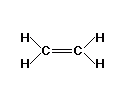
Ethylene
|
-
Directly induced by high levels of Auxin (Rubinstein & Leopold, 1964)
-
Found in germinating seeds (Esashi & Leopold, 1970)
-
Induced by root flooding (Kawase, 1972; El-Beltagy et al., 1974; Imaseki, 1985)
-
Induced by drought (El-Beltagy et al., 1974)
-
Synthesized in nodes of stems
-
Synthesized in tissues of ripening fruits
-
Synthesized in response to shoot environmental, pest, or disease stress
-
Synthesized in senescent leaves and flowers
-
Rapidly diffuses
-
Inhibiting effects of Ethylene on shoot growth (more specifically on stem elongation) reduced in the presence of light (Wareing & Phillips, 1981). Also Ethylene levels are decreased by light (Goeschl et al., 1967)
-
Released by mature cells when they have less than enough minerals and water to support both themselves and any dependent cells under any conditions (less than survivable levels of minerals and water)
-
Alternatively Ethylene is released when it has any scarcity of minerals and water below which it had previously and is proportional to the scarcity
-
Third possibility is it is released when minerals and water fall below those needed for peak metabolism levels (a maximum level of nutrients beyond which growth or nutrient storage is induced) and is proportional to gap between peak metabolism levels and the current level
-
Released in when they do not have enough minerals and water to support both themselves and any dependent cells
-
Released by all cells when they are experiencing conditions which would normally cause a mature shoot cell to produce Ethylene
|
-
Stimulates leaf and flower senescence (Wareing & Phillips, 1981)
-
Induces leaf abscission (El-Beltagy et al., 1974) mainly in older versus younger leaves (Leopold, 1970)
-
Induces seed germination (Esashi & Leopold, 1969; Ketring & Morgan, 1970)
-
Induces root hair growth – this increases the efficiency of water and mineral absorption
-
Stimulates Epinasty – leaf petiole grows out, leaf hangs down and curls into itself
-
Stimulates fruit ripening
-
Induces the growth of adventitious roots during flooding
-
Usually inhibits growth (El-Beltagy et al., 1974) - just shoot growth
-
Affects neighboring individuals
-
Disease/wounding resistance
-
Triple response when applied to seedlings – root ? and shoot growth inhibition and pronounced hypocotyl hook bending
-
Inhibits stem swelling ? (Contradictory to the finding below – contradictory sources)
-
Stimulates cell broadening (Burg & Burg, 1966) (and lateral root growth)
-
Interference with Auxin transport (when hormone levels are increasing)
-
Directly or indirectly induces Auxin at high levels
-
(From Theory II) Inhibits the rate of metabolism of cells in the shoot (who are not already at their lowest metabolism rates) in response to an decrease in the levels minerals and/or water
|
|
Gibberellins (GAs)
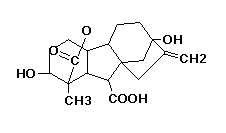
Gibberellin 452D
|
-
Synthesized in the embryo (Webb et al., 1973) and germinating seeds
-
Synthesized in the roots (Barrington, 1975)
-
Levels go up in the dark when sugar cannot be manufactured and down in the light (Brown et al, 1975)
-
Synthesized in apical meristems ? and young leaves ?
-
Produced in the stem rather than the growing tip ? (opposite finding to above – conflicting sources)
-
Transport is non-polar, bidirectional producing general responses
-
Released by meristematic cells when they have more than enough Sugar ,carbon dioxide and oxygen to support both themselves and any dependent cells in peak metabolism conditions
-
Released by mature cells when they have less than enough sugar and gases to support both themselves and any dependent cells under any conditions (less than survivable levels of minerals and water)
-
Alternatively Ethylene is released when it has any scarcity of sugar and gases below which it had previously and is proportional to the scarcity
-
Third possibility is it is released when sugar and gases fall below those needed for peak metabolism levels (a maximum level of nutrients beyond which growth or nutrient storage is induced) and is proportional to gap between peak metabolism levels and the current level
-
Released by all cells when they are experiencing conditions which would normally cause a mature root cell to produce GA or BR
-
Released in response to root environmental, pest, or disease stress
-
Directly induced by high levels of CK
|
-
Stimulates shoot and cell elongation (Engelke et al, 1973)
-
Delays senescence of leaves (Manos & Goldthwaite, 1975; Goldthwaite, 1972)
-
Inhibits root growth (Thimann, 1977; Mitsuhashi-Kato et al., 1978)
-
Inhibits adventitious root growth (Rossel ?)
-
Produces seed germination (Egley, 1980)
-
Antagonist promotes root growth and GA reverses this (Kefford, ?)
-
Promotes root initiation in low concentration in pea cuttings (Eriksen, 1970, 1971)
-
Stimulates bolting and flowering in biennials (Zeevaart, 1983)
-
Regulates production of hydrolytic enzymes for digesting starches (Varner, 1964)
-
Inhibits CK bud growth on calluses (Engelke et al., 1973)
-
Inhibits bud formation (Murashige, 1964)
-
Inhibits leaf formation (Bryan et al., 1955; Tronchet, 1968)
-
Breaking of dormancy
-
Induces extra Chlorophyll production or more efficient methods of photosynthesis (C4Photsynthesis). I think this reference actually exists
-
Stimulates root senescence
-
Directly or indirectly induces CK at high levels
-
(From Theory II) Inhibits the rate of metabolism of cells in the roots (who are not already at their lowest metabolism rates) in response to an decrease in the levels sugar and/or essential gases
|
|
Abscisic Acid (ABA)
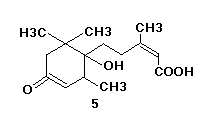
Abscisic Acid
|
-
Released during desiccation (Wain, 1975)
-
Has been found to peak at night (Lecoq et al., 1983 a, b)
-
Synthesized in green fruit and seeds at the beginning of the wintering period
-
As well as moving within the leaf it can be transferred to the leaf from the roots by the transpiration stream
-
Rapidly translocated
-
Produced in response to stress
-
Synthesized in leaves and stems (particularly when water stressed)
-
Released by cells in danger of not having enough nutrients locally or good enough environmental conditions to survive
-
All cells capable of synthesizing
|
-
Stimulates stomatal closure (Wain 1975)
-
Fruit ripening inhibition
-
Encourages seed dormancy by inhibiting cell growth – inhibits seed germination
-
ABA inhibits the uptake of Kinetin (Reed, 1974)
-
Pathogen resistance response defense -
-
Induces senescence in already damaged cells and their proximate neighbors
-
Quickly puts a plant, organ, tissue or individual cell in a defensive posture (whatever this entails) in response to rapidly developing nutrient or environmental stress that threaten their survival
-
Decreases metabolism in response to a newly developing deficiency of nutrient or adverse environmental condition, such that condition becomes survivable at the new lower level of metabolism (Not true in Theory II)
-
Possibly induces cell dormancy or senescence by a climacteric increase or sustained level stimulating the synthesis of GA and/or Ethylene (Not true in Theory II)
-
A climacteric rise or sustained level of ABA may be a prerequisite for the synthesis of any GA and/or Ethylene in that it presence indicates unusable or unsurvivable levels of Water, Sugar, Minerals and/or essential gases (Not true in Theory II)
|
|
Brassinosteroids (BRs)
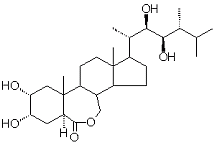
Brassinolid
|
-
Released in mature cells when they have less than enough sugar and oxygen to support both themselves and any dependent cells
-
Released by all cells when they are experiencing conditions which would normally cause a mature root cell to produce BR or GA
-
Released in response to root environmental, pest, or disease stress
|
-
Increased rate of stem elongation (Thompson et al., 1982)
-
Leaf senescence inhibition
-
Involved in gravitropism
-
Bending of grass leaves at the sheath/blade joints
-
Inhibits leaf abscission
-
Inhibits root growth
-
Resistance to stress - just in the shoot. By rerouting resources from the root to the stressed shoot
-
Stimulates cell elongation and division (Thompson et al., 1982) – just in the shoot
-
Enhanced Ethylene production ? – induced indirectly by the causation of root cell senescence
-
Promotion of growth - just shoot growth
-
Xylem differentiation promotion - in order to transfer resources from cannibalized root cells
-
(From Theory II): inhibits the rate of metabolism of cells in the shoot (who are not already at their lowest metabolism rates) in response to an decrease in the levels sugar and/or essential gases
|
|
Jasmonates
(JAs)
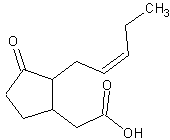
Jasmonic Acid
|
-
Desiccation
-
Effect of elevated ABA levels
-
JA-induced proteins are lacking in the roots, in bleached leaves, and in leaves of chlorophyll-deficient
|
-
Growth inhibition
-
Senescence promotion
-
Stimulates wound responses
-
Germination inhibition
-
Tuber formation promotion
-
Fruit ripening and fruit abscission promotion
-
Pigment formation promotion
-
May have a role in plant defense
|
|
Salicylates (SAs)
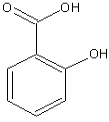
Salicylic Acid
|
-
Cells returning from water stress
-
Released by cells secure in having more than enough nutrients and environmental conditions locally to survive at its current metabolic level
-
All cells capable of synthesizing
-
Has its effect or acts by rapid local increases followed by rapid decreases in levels
|
-
Retards senescence (regulatory role) – probably by inhibiting Ethylene biosynthesis
-
Induces flowering
-
Inhibits seed germination – by inhibiting ABA synthesis
-
May also block the wound response and act antagonistically to ABA – preventing the wound response from spreading further than necessary
-
After a survival threat has passed SA quickly removes a plant, organ, tissue or cell from a defensive posture and returns it to normal functioning
-
Increases cell metabolism rate to take advantage of new complete more advantageous nutrient and environmental conditions (Not true in Theory II)
-
A climacteric or sustained level of SA may occur if a cell has reached its peak metabolic levels and may signal that a plant’s resources can be turned to growth (Not true in Theory II)
-
This climacteric or sustained level of SA may be a prerequisite for the synthesis of Auxin and/or Cytokinin, because only then does a plant know that it has enough resources to turn them to growing bigger (Not true in Theory II)
|
|
Oligogalacturonides -
Pectin-Derived Polymers
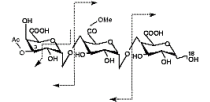
|
|
|
|
Xyloglucan -
e.g. Hemicellulose -
Derived Polymers
Click here to see
Graminaceous hemicellulose
|
|
-
Stimulates cell elongation and growth
-
Stimulates defense responses
-
Stimulates morphogenesis (in culture)
-
A compounding/magnifying element of the Auxin pathway.
|
Table suggested by first link. Some info also pulled from all links below as well as my own research:
|









